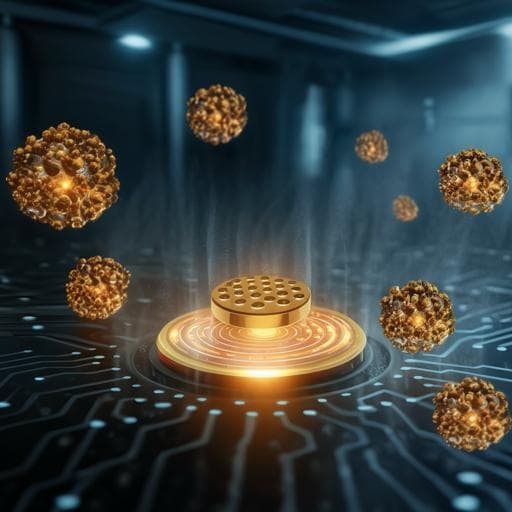
Physics
Neural network enabled nanoplasmonic hydrogen sensors with 100 ppm limit of detection in humid air
D. Tomeček, H. K. Moberg, et al.
Discover groundbreaking advancements in hydrogen sensing technology, achieved through innovative optical nanoplasmonics. This research, conducted by David Tomeček and colleagues, showcases a sensor that can detect hydrogen at an impressive 100 ppm limit even in humid environments, outpacing existing benchmarks.
~3 min • Beginner • English
Introduction
The study addresses the critical challenge of hydrogen sensor operation under high humidity, a common condition in fuel cells, electrolyzers, and environmental deployment. Hydrogen-air mixtures are highly flammable, requiring sensitive, reliable sensors for safety and process control. While various H₂ sensor types exist, optical nanoplasmonic sensors based on localized surface plasmon resonance (LSPR) in Pd or Pd-alloy nanostructures offer advantages including selectivity and fast response. However, their performance degrades at elevated relative humidity (RH), which conflicts with ISO 26142:2010 requirements for robust operation between 20–80% RH and US DOE targets of LoD ≤0.1% H₂ in humid air. The research questions are: (1) Can plasmonic Pd₇₀Au₃₀ sensors be operated at elevated temperature to mitigate humidity-induced deactivation and restore robust response up to 80% RH? (2) Can machine-learning-based analysis of full extinction spectra (DDNN/Transformer) reduce the limit of detection in humid air to meet or surpass DOE targets, potentially down to 100 ppm? The study maps humidity/temperature effects, elucidates surface chemistry mechanisms, and evaluates ML-enhanced readout for LoD, robustness, and long-term stability.
Literature Review
Prior work established numerous H₂ sensing platforms (resistive, electrochemical, catalytic, thermal conductivity). Nanoplasmonic sensors using Pd or Pd-alloy nanoparticles or perfect absorbers leverage LSPR shifts caused by hydrogen absorption and have demonstrated few-hundred-ppb LoD in dry conditions, sub-second response at ~1000 ppm, high selectivity, and resistance to deactivation by several gases through alloying and polymer coatings. Other metals (e.g., Mg, Y) have been explored for active plasmonics with hydrogen. Nonetheless, humidity tolerance remains a key gap. Notably, Pd₈₀Co₂₀ sensors lose ~32% response to 2% H₂ at just 40% RH (25 °C), with PMMA coatings only partially mitigating. Systematic studies above 40% RH or strategies to ensure robust 20–80% RH performance are scarce, despite ISO 26142:2010 and DOE requirements. This work builds on prior PdAu sensor developments that eliminate hysteresis and provide linear optical response, extending them into high-humidity operation.
Methodology
Sensor platform: Quasi-random arrays of Pd₇₀Au₃₀ nanodisks (mean diameter ~198 nm, height 25 nm) were fabricated on fused silica via hole-mask colloidal lithography. After deposition, arrays were annealed at 500 °C for 18 h in 4% H₂/Ar to form a homogeneous alloy. STEM/EDS confirmed uniform composition (Pd₇₃±8Au₂₇±9). LSPR-based optical extinction was measured in transmission.
Measurement setup: A quartz tube flow reactor (Insplorion X1) with optical access was used at atmospheric pressure with synthetic air (80% N₂/20% O₂). Total flow 200 mL min⁻¹ controlled by MFCs. Humidity 0–80% RH at 29 °C generated by a controlled evaporation mixing system and monitored by a calibrated RH/T probe. Sensor temperature was controlled between 30–130 °C via a closed-loop controller. Illumination by halogen lamp (Avantes), spectra (400–1000 nm) recorded by fiber-coupled spectrometers (AvaSpec series). Additional pure H₂ isotherms were obtained in a vacuum chamber to map Pd₇₀Au₃₀Hₓ behavior.
Standard readout: The centroid shift of the LSPR peak, Δλ_peak, was computed using an interpolated centroid algorithm over a fixed base span S (typically 140 nm; 125 nm in long-term tests) to maximize S/N. Baseline noise σ ≈ 0.027 ± 0.015 nm was quantified. LoD followed the IUPAC 3σ criterion, using interpolation/extrapolation where needed.
Test protocols:
- ISO 26412:2010-derived protocol: Initialization (6×10% H₂ in Ar, then 6×1.3% H₂ in air at 80 °C), then core mapping of responses to H₂ pulses (0.06–1.3% in log steps) at RH = 0, 20, 50, 80% and T = 30, 55, 80, 105, 130 °C, followed by dry control sequences. Humidification reference at 29 °C.
- Long-term stability protocol: At 80 °C, after initialization and a dry reference, 190 pulses at RH 80% organized in 10 regular and 9 randomized subsets over ~114 h, followed by dry control with an interim 100 °C drying step. Total duration ~142.5 h. A self-referencing procedure mitigated long-term baseline drift from light source intensity fluctuations.
- Intermediate humidity protocol: At 80 °C, responses to H₂ pulses (0.06–1.3%) were mapped at RH = 0, 20, 35, 50, 75, 85%, including a dry control.
- Low-concentration protocol: At 80 °C, pulses spanning 0.01–0.22% H₂ at RH = 0, 20, 50, 80%, with dry control; initialization used 6×10% H₂ in Ar and 6×0.22% H₂ in air.
Machine learning readouts:
- DDNN: A deep dense neural network with batch normalization, dense and dropout layers with skip connections and a multi-head attention module processed full spectra time series (400–1000 nm) to output H₂ concentration per time step. Trained supervised with spectrum–label pairs (c_H₂) using on/off ramps.
- Transformer: For long sequences and improved temporal modeling, an NLP-inspired Transformer with positional encoding and self-attention over spectral sequences was used, integrated with the DDNN base. It outputs time-resolved H₂ concentration. Models were trained on datasets collected at specified RH/temperature conditions; retraining on enriched datasets (intermediate RH, lower concentrations) was performed to improve generalization. LoD estimation for ML outputs used prediction precision σ(c_H₂) modeled vs concentration (logarithmic fit) to infer the lowest c_H₂ measurable at 3σ precision.
Key Findings
- Humidity deactivation at low temperature: At 30 °C, Pd₇₀Au₃₀ sensors show strong degradation with increasing RH. For 1.3% H₂, Δλ_peak decreases from 6.4 nm (dry) to 0.2 nm (80% RH), a 97% reduction. Low c_H₂ pulses produce negative shifts (blue-shifts) due to surface reactions between H_ads and OH_ads; baseline Δλ_peak red-shifts linearly with RH due to H₂O/OH adsorption. Standard Δλ_peak-based LoD degrades from ~0.005% in dry to ~1.1% at 80% RH (30 °C).
- Elevated temperature mitigates humidity effects: Raising temperature to 80–130 °C shifts surface coverage equilibria, restoring H₂ dissociation/absorption and eliminating the negative-response valley. At 80 °C and 1.3% H₂, responses at RH 0% and 80% are 2.4 nm and 1.8 nm, respectively (only ~15% reduction). The threshold c_H₂ for positive Δλ_peak at 80% RH decreases from ~0.9% at 30 °C to ~0.13% at ≥105 °C. However, higher T reduces absolute signal amplitude due to lower H solubility, increasing LoD in dry conditions.
- Standard readout LoD vs RH/T: With Δλ_peak readout, the best case (105 °C) achieves LoD ≈ 0.04% in dry air but ≈ 0.15% at 80% RH, slightly missing the DOE target of 0.1% at high RH.
- Full-spectrum ML readout boosts sensitivity: DDNN analysis of full spectra resolves the low-c_H₂ ambiguity and lowers LoD in 80% RH to 0.02–0.06% H₂ (200–600 ppm) for 80–130 °C, meeting and exceeding the DOE 0.1% target. LoD estimation used a σ(c_H₂) logarithmic model to extrapolate below 0.06%.
- ISO 26142:2010 robustness: Using Δλ_peak, the requirement (±30% response variation between RH 20–80%, referenced to 50% RH) is met at 105 °C down to 0.28% H₂; at 0.13% no T passes. Using DDNN, all T pass at 1.3% and 0.6% H₂; at 0.28% and 0.13%, all but 30 °C meet; at 0.06% H₂, 80 °C meets and 55 °C is close.
- Long-term stability: Over 142 h at 80% RH and 80 °C (190 pulses), the sensor shows no degradation. Transformer-based readout provides stable, linear predictions for both regular and randomized sequences. The discrete LoD remains at 0.06% H₂ throughout, with evidence suggesting even lower detectable levels.
- Generalization and retraining: Applying models to intermediate RH not included in training yields reduced accuracy at lowest concentrations; retraining with enriched RH data restores performance and maintains RH-independent LoD well below 0.1%. Extending to c_H₂ down to 0.01% (100 ppm) shows the old model underperforms at the new low range, while a retrained Transformer reliably detects 0.01% H₂ at all RH. The best achieved LoD is 0.01% (100 ppm) at 80% RH in air.
- Noise and S/N: Baseline noise σ ≈ 0.027 ± 0.015 nm is largely independent of T, RH, and c_H₂; ML methods leverage full spectral information to maintain precision despite small or sign-inverted Δλ_peak.
Discussion
The work identifies and mechanistically explains humidity-induced deactivation in Pd₇₀Au₃₀ LSPR H₂ sensors: H₂O/OH adsorption blocks active sites, elevates the optical baseline (red-shift), and at low c_H₂ drives a competing surface reaction (H_ads + OH_ads → H₂O) that consumes dissociated H and causes blue-shifts, preventing bulk absorption. Operating at elevated temperature shifts the surface equilibrium to favor H adsorption and desorption of H₂O, restoring access to interstitial absorption and robust plasmonic signals even at RH 80%. This addresses the core research question of enabling humidity tolerance up to 80% RH.
However, higher temperatures reduce hydrogen solubility and optical contrast, increasing LoD when using single-parameter readouts. Incorporating the full spectral signature through DDNN and Transformer models overcomes sign ambiguities and exploits subtle spectral changes beyond Δλ_peak, substantially lowering LoD and making it largely RH-independent. The ML approach also improves robustness (meeting ISO 26142:2010 down to lower c_H₂) and provides stable long-term readout under fluctuating conditions.
The study highlights that deep learning models must be trained within the intended operating envelope (RH levels, concentration range, noise characteristics) to maintain accuracy, with straightforward retraining enabling extension to new conditions. The findings underscore a general strategy: combine temperature control to mitigate surface poisoning with ML-based full-spectrum analysis to push sensitivity and robustness beyond conventional limits, applicable to other nanoplasmonic sensors and Pd-capped systems.
Conclusion
This work demonstrates humidity-tolerant nanoplasmonic H₂ sensing using Pd₇₀Au₃₀ nanodisks operated at elevated temperatures and augmented by neural-network-based full-spectrum analysis. Key contributions include: (1) mechanistic mapping of humidity deactivation and its mitigation by temperature (80–130 °C), (2) ML-enabled readout (DDNN/Transformer) that reclaims ambiguous low-concentration regimes and achieves LoD of 0.02–0.06% H₂ at 80% RH and, after retraining, a record 0.01% (100 ppm) LoD at 80% RH, surpassing the DOE target, (3) compliance with ISO 26142:2010 robustness down to 0.06% H₂ at 80 °C using ML readout, and (4) long-term stability over 142 h in 80% RH without degradation. The approach is generic and suggests that combining controlled sensor operation conditions with deep learning can extend applicability across diverse environments without hardware changes.
Future directions include: optimizing sensor materials and temperatures to balance signal amplitude and deactivation resistance; broader, curated training datasets spanning wider RH, temperature, and concentration ranges to reduce retraining needs; exploring advanced architectures for even better generalization; integrating on-device or edge ML for real-time deployment; and extending the methodology to other analytes and plasmonic platforms.
Limitations
- Temperature–signal trade-off: Elevated operation temperatures mitigate humidity poisoning but reduce hydrogen solubility and optical contrast, lowering S/N in dry conditions and increasing LoD with standard readouts.
- Readout ambiguity at low concentrations: Conventional single-descriptor analysis (Δλ_peak) exhibits blue-shifts at low c_H₂ in humid air, forcing exclusion of informative regimes and inflating LoD.
- Model generalization: Deep learning models show reduced accuracy when applied outside their training conditions (intermediate RH, lower c_H₂). Performance recovery requires retraining with representative data and noise characteristics.
- Noise and drift: LoD estimates depend on accurate characterization of baseline noise and inference-time noise. Long-term optical baseline drift (e.g., light source intensity) necessitates self-referencing and can affect standard analyses.
- Protocol deviations: Humidification reference temperature (29 °C) differs from ISO standard (40 °C) due to experimental constraints, which may slightly affect generalizability of absolute figures.
- Extrapolated LoD: Some LoD values are inferred via logarithmic fits to prediction precision below the lowest applied concentration, introducing modeling assumptions.
Related Publications
Explore these studies to deepen your understanding of the subject.







